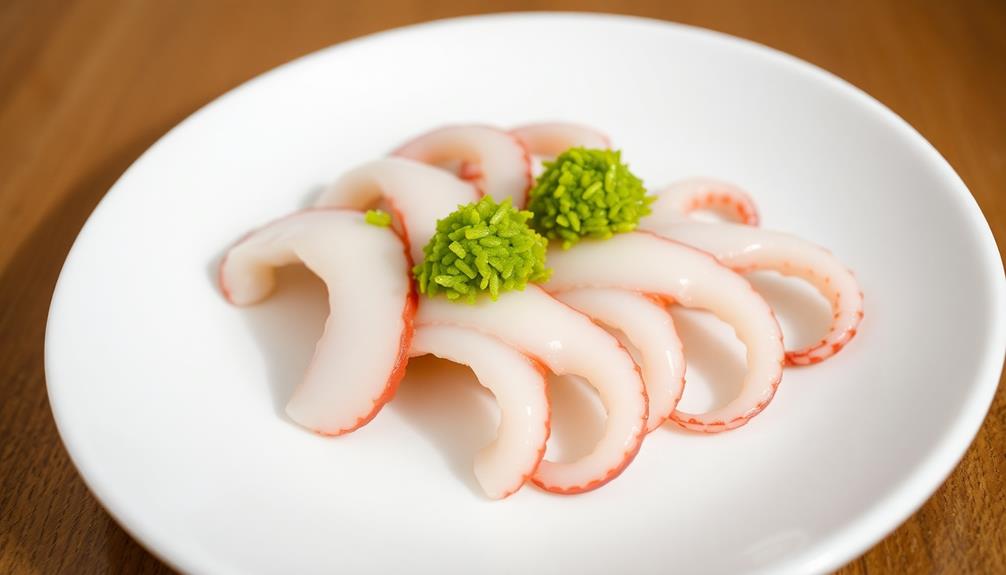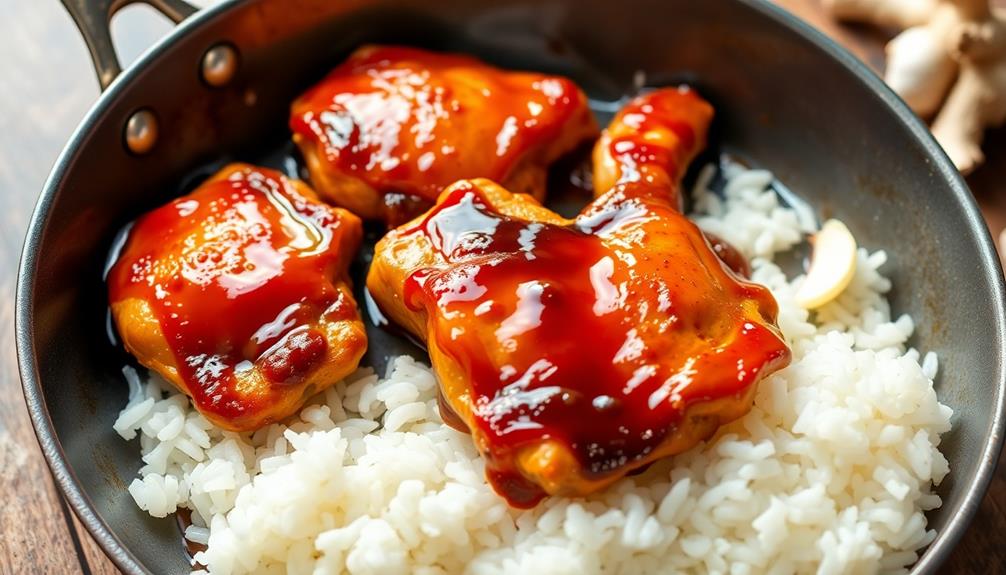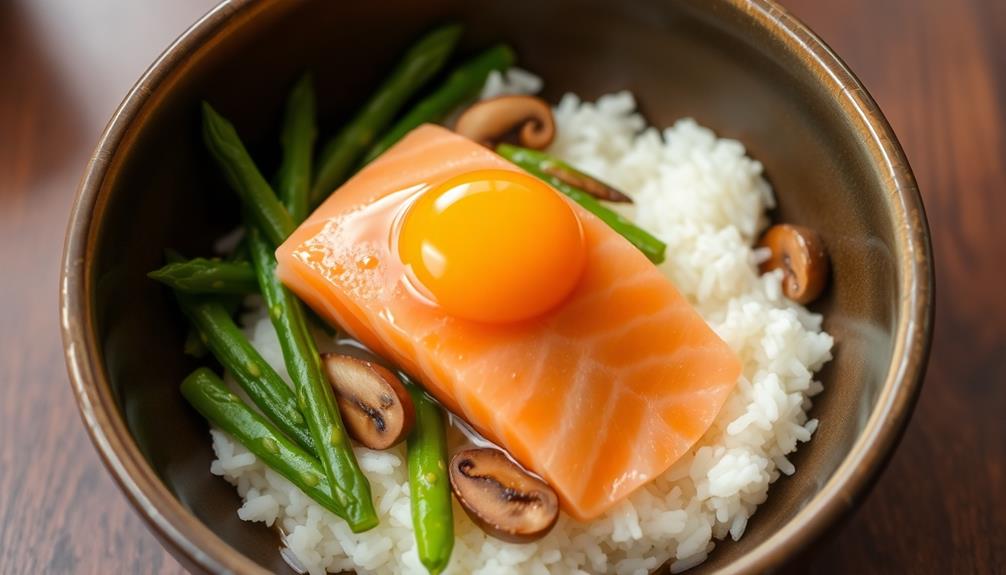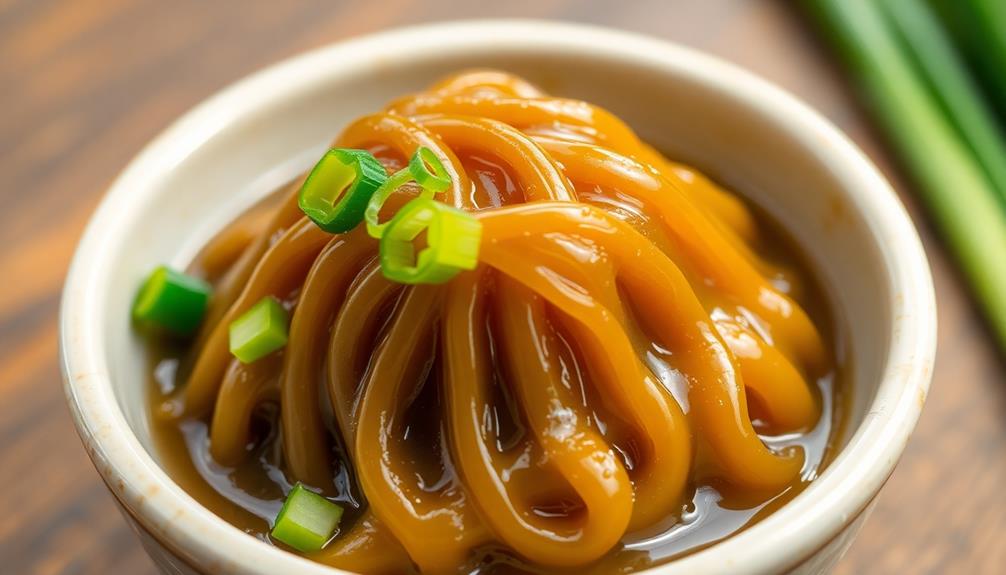Have you ever experienced the bold and captivating flavors of takowasa? This traditional Japanese dish, featuring raw octopus paired with the fiery punch of wasabi, has enchanted palates for centuries. Its origins trace back to the Edo period, when it symbolized refined taste and cultural sophistication. Prepare to tantalize your senses as you discover the unique textures and harmonious blend of ingredients that make takowasa a true culinary delight. Uncover the secrets behind this iconic dish, and you'll soon understand why it remains a beloved staple in Japanese cuisine.
Key Takeaways
- Takowasa is a Japanese dish featuring raw octopus and wasabi, known for its unique texture and bold flavors.
- It originated during the Edo period and has since become an integral part of Japanese culinary culture, symbolizing refined taste and sophistication.
- The dish combines the freshness of seafood with the heat from wasabi, and is often served as an appetizer or part of a sushi platter.
- Preparation involves precisely slicing the octopus and incorporating freshly grated wasabi, with optional garnishes like sesame seeds, green onions, or microgreens.
- Takowasa is best served chilled, paired with sake or Japanese beer, and can be enjoyed as part of a larger tasting menu or shared with others.
History
The origins of takowasa, the delicacy of raw octopus served with wasabi, can be traced back to traditional Japanese cuisine. This unique dish has been enjoyed for centuries, with its roots firmly planted in the country's rich culinary heritage.
Takowasa first gained popularity during the Edo period (1603-1868), when the samurai class and aristocracy of Japan embraced the dish as a symbol of refined taste and cultural sophistication. The pairing of fresh, succulent octopus with the fiery kick of wasabi became a beloved and cherished gastronomic experience.
Over time, takowasa has evolved, with different regions and chefs adding their own unique touches and interpretations. From the delicate balance of flavors to the meticulous preparation techniques, the tradition of takowasa continues to captivate and delight food enthusiasts both in Japan and around the world.
Today, it remains a beloved and integral part of Japanese culinary culture, a testament to the enduring appeal of this remarkable dish.
Recipe
Takowasa, or raw octopus with wasabi, is a popular Japanese appetizer known for its bold flavors and refreshing texture. The dish showcases the natural sweetness of the octopus balanced by the pungent kick of wasabi. Preparing takowasa is a simple yet delightful culinary experience. Takowasa is often served at traditional izakayas or as part of Japanese street food offerings, providing a quick and satisfying snack for those on the go. Its popularity stems from the combination of fresh, high-quality ingredients and the skillful preparation that brings out the best of the octopus and wasabi. When visiting Japan, trying takowasa is a must for experiencing the vibrant and diverse world of Japanese cuisine.
The key to a successful takowasa lies in the freshness of the octopus and the quality of the wasabi. Opt for the freshest octopus available, as this will ensure a tender, succulent texture. Additionally, the wasabi should be freshly grated, as it quickly loses its potency once exposed to air.
- Fresh octopus, thinly sliced
- Freshly grated wasabi
- Soy sauce (for serving)
To prepare the dish, simply arrange the thinly sliced octopus on a plate or platter. Generously top the octopus with the freshly grated wasabi, ensuring each piece is evenly coated. Serve the takowasa immediately, accompanied by soy sauce for dipping.
When enjoying takowasa, it's important to handle the wasabi with caution. The spiciness can be quite intense, so start with a small amount and gradually increase to suit your personal preference.
The combination of the cool, tender octopus and the fiery wasabi creates a delightful contrast that tantalizes the palate.
Cooking Steps
Carefully slice the octopus into thin, delicate pieces.
Generously add freshly grated wasabi, which will provide a delightful punch of heat.
Serve the takowasa immediately on individual plates, garnishing with even more grated wasabi and a sprinkle of toasted sesame seeds for a visually stunning and flavorful presentation.
Step 1. Carefully Slice Octopus Into Thin Pieces
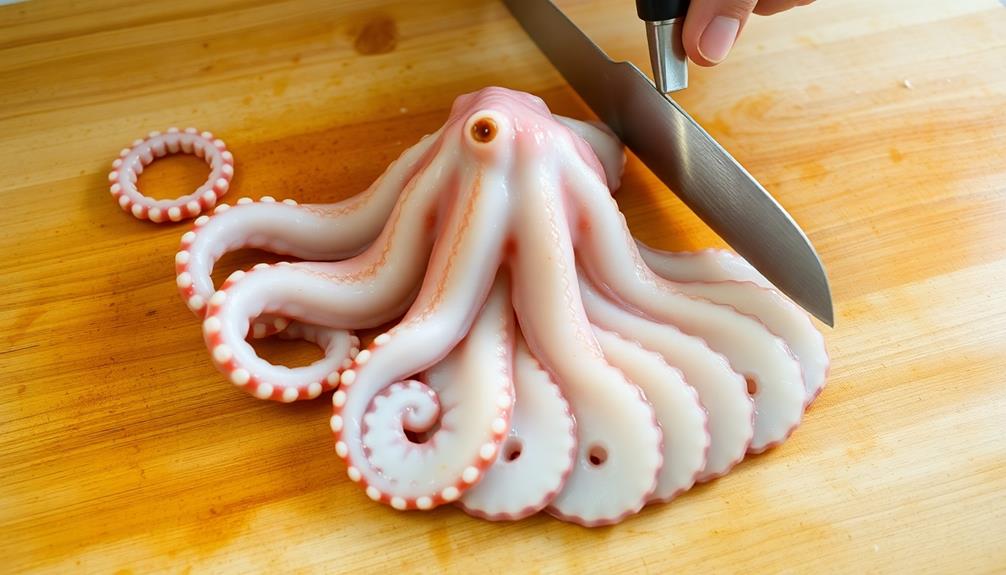
Grab your sharpest knife and gently lay the octopus on a clean cutting board. Carefully slice the tentacles into thin, uniform pieces, about 1/4 inch thick. This delicate process requires a steady hand and a keen eye. Take your time, slicing at a slight angle to create those perfect, translucent slices.
Next, move on to the head of the octopus. Carefully slice it in half lengthwise, then into thin strips. The key is to slice the octopus across the grain, ensuring a tender, delicate texture. Work slowly and with precision, maintaining control of the knife to achieve those beautiful, paper-thin pieces.
As you create each slice, arrange the octopus on a serving platter, overlapping the pieces slightly for a visually stunning presentation. This step-by-step approach will result in a gorgeous display of fresh, raw octopus that's ready to be paired with the bold, pungent flavor of wasabi.
Step 2. Add Wasabi
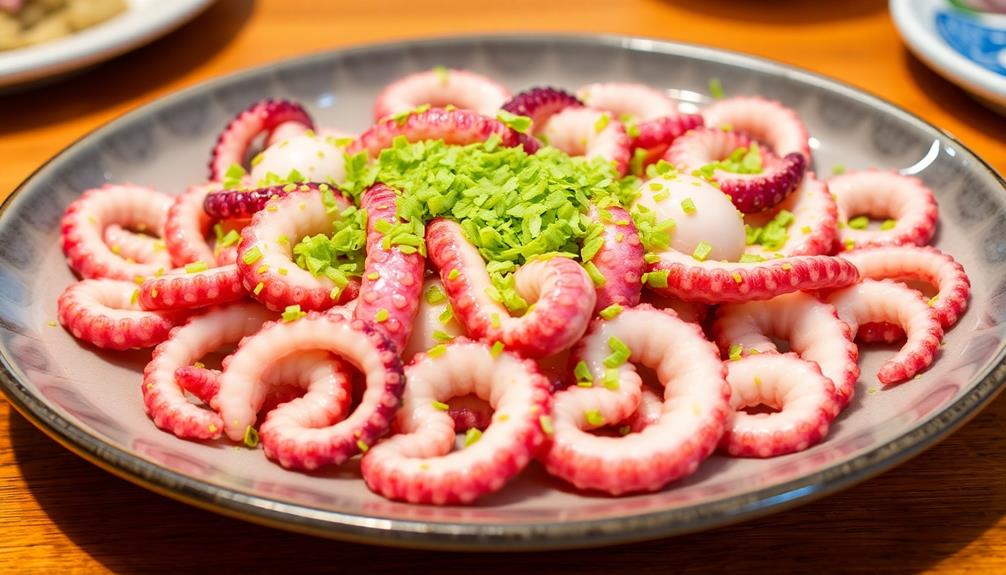
With the octopus sliced to perfection, it's time to add the bold and pungent wasabi. Wasabi, a Japanese condiment made from a root in the horseradish family, provides a kick of spice that pairs beautifully with the delicate flavor of the raw octopus.
Carefully measure out about a teaspoon of freshly grated wasabi per serving of octopus. You can adjust the amount to suit your personal taste, adding more for a stronger kick or less for a milder experience.
Gently mix the wasabi into the sliced octopus, ensuring each piece is coated evenly. The combination of the cool, slippery octopus and the fiery wasabi creates a sensational contrast in both texture and flavor.
The wasabi's heat will dance across your tongue, while the octopus' tender, almost creamy, texture provides a soothing counterpoint. Serve the takowasa immediately, allowing your guests to experience the dynamic interplay of these two bold ingredients.
Step 3. Serve Immediately on Individual Plates

Once the wasabi is evenly incorporated, it's time to serve the takowasa immediately on individual plates. This is a dish best enjoyed at the peak of freshness, so don't let it sit around.
Grab a plate and place a small portion of the raw octopus on it, being careful to arrange the pieces neatly. The bright pink flesh and vibrant green wasabi should create an eye-catching contrast.
Now, it's important to serve the takowasa while it's still cold and crisp. The texture of the tender octopus and the pungent kick of the wasabi are what make this dish so special.
Encourage your guests to take their time and savor each bite, letting the flavors dance on their tongues. The wasabi may be quite intense, so advise them to start with small amounts and gradually increase the dose to suit their personal preferences.
Step 4. Garnish With Freshly Grated Wasabi
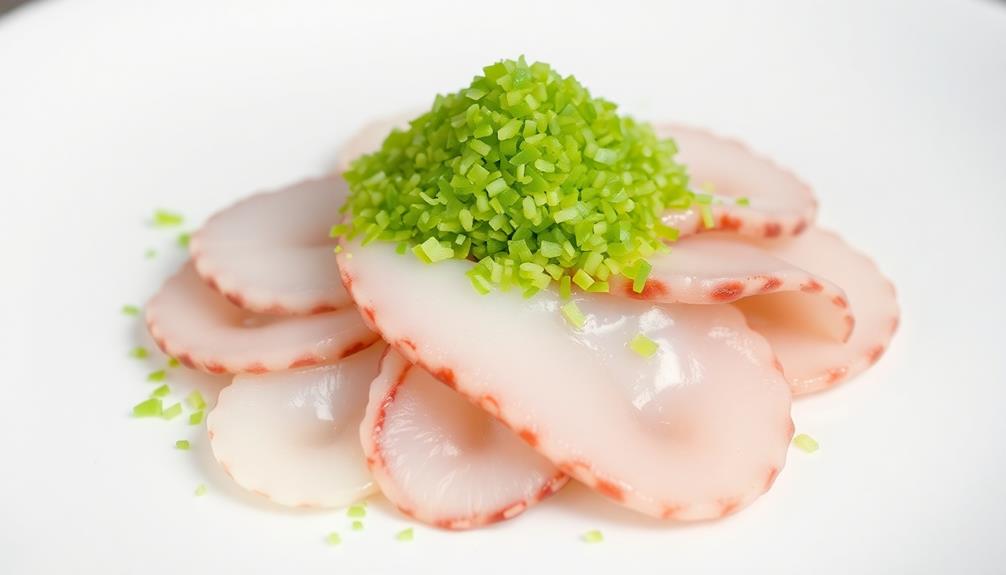
To finish off the takowasa, you'll want to grate some fresh wasabi to use as a garnish. Wasabi, a pungent Japanese root, adds a delightful zing to this dish.
Start by selecting a fresh wasabi root – the greener and more vibrant, the better. Using a fine grater or microplane, carefully grate the wasabi, applying gentle pressure to extract the maximum flavor.
Sprinkle the grated wasabi evenly over the top of the octopus slices, ensuring each piece is adorned with the fiery green goodness. The wasabi's pungent aroma and spicy kick will perfectly complement the cool, delicate octopus.
Be generous with the wasabi, as its intensity will mellow once combined with the other flavors. Serve the takowasa immediately, allowing your guests to experience the harmonious interplay of the raw octopus and the freshly grated wasabi.
This final touch will elevate the dish, creating a truly authentic Japanese dining experience.
Step 5. Sprinkle With Toasted Sesame Seeds

Sprinkle a handful of toasted sesame seeds over the grated wasabi-topped octopus slices. The nutty, crunchy sesame seeds provide a delightful contrast to the soft, briny octopus and the fiery kick of the wasabi. Gently press the seeds into the octopus to help them adhere.
The toasted sesame seeds add a lovely visual appeal, creating a vibrant, multi-textured dish. Their rich, aromatic flavor also complements the other ingredients beautifully. Be generous with the sesame seeds, as they'll enhance both the taste and the appearance of the takowasa.
Once the sesame seeds are evenly distributed, your dish is ready to serve. The combination of the raw octopus, grated wasabi, and toasted sesame seeds creates a harmonious blend of flavors and textures that will delight your guests.
Enjoy this authentic Japanese delicacy with friends and family, savoring each flavorful bite.
Final Thoughts
Although takowasa may seem like an intimidating dish to prepare, you shouldn't be deterred from trying it. The raw octopus and wasabi combination might seem daunting at first, but once you give it a chance, you'll be pleasantly surprised by the fresh, vibrant flavors.
The key is to use the freshest, highest-quality ingredients available. Don't be afraid to experiment with different wasabi varieties to find the one that best suits your taste buds. The toasted sesame seeds add a delightful crunch that complements the soft octopus perfectly.
Embrace the unique texture and bold flavors of takowasa – it's a true culinary adventure that will impress your friends and family. With a little practice, you'll be serving up this impressive Japanese delicacy like a pro.
